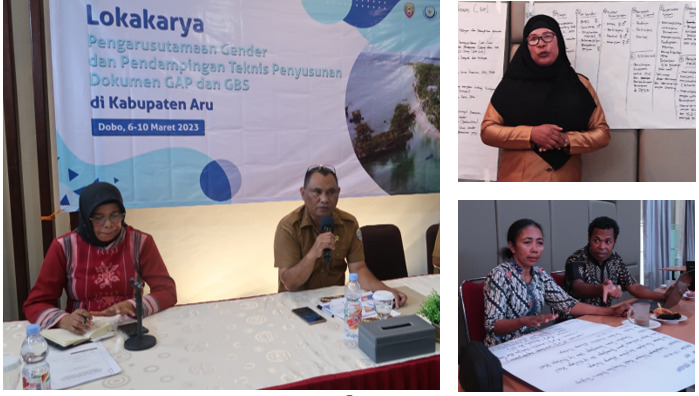Through gender mainstreaming and capacity-building programs, the ATSEA-2 Project is committed to promoting gender equity in the sustainable management of coastal resources. From 6-10 March 2023, the project hosted a gender workshop in Dobo, Aru Archipelago. A total of 34 people attended, comprising representatives from national, provincial and district government departments, a women’s organisation, non-government organisations and the ATSEA-2 National Coordinator Unit Indonesia.
The workshop covered multiple topics related to gender and marine economic development. Attendees learned about basic gender concepts and their relevance to the field, as well as wider gender issues. The participants also had a chance to see the results of a gender assessment that was conducted in 2021, which revealed the disparities between men and women in terms of access to marine and fisheries resources, including capacity building and fisheries technologies. In addition, the workshop provided practical tools for conducting gender analysis and budgeting, with the goal of promoting equal rights for greater development outcomes.
Laeli Sukmahayani is the ATSEA-2 Gender Specialist. During the workshop, she emphasised the importance of understanding basic gender concepts. “The understanding of basic gender concepts is vital in mapping gender gaps or issues in coastal communities,” said Sukmahayani. “It is known that one of the poverty pockets is in coastal areas that are dominated by women; therefore, this knowledge can help the government plan development programs that promote gender equality for both men and women.”
The workshop featured presentations on gender mainstreaming policy and programs at the national, provincial and district levels. Helsyanita, Assistant Deputy of Gender Equality in the field of Economy at the Ministry of Women’s Empowerment and Child Protection of the Republic of Indonesia (KPPPA), presented the national perspective on gender mainstreaming policy and programs. She explained that, although there has been an increase in the Gender Development Index (GDI) from 2020-2021, women’s involvement is still far below the target of 30%.
Maimuna Tualeka, Head of the Quality of Life for Women and Families Division at the Department of PPPA Maluku province, also shared some insights from a provincial perspective: “the Gender Empowerment Index (GEI) in Maluku has remained stagnant for the past three years from 2019-2022 at 75.54%. Although there are more women represented in the Maluku government, when it comes to education and positions of authority, women lag significantly behind men”. Hendrick Haluruk, who is Head of the Social and Cultural Division at the Regional Planning and Development Agency in Aru, added that “the condition is further compounded by the very low quality of education and healthcare services”.

During the workshop, participants engaged in several group discussions, during which they developed a schedule for men and women in coastal communities in Southeast Aru to analyse the disparities between their triple roles (productive, reproductive and community). The participants identified key areas for improvement in the Aru Archipelago to reduce the gender gap, including ensuring equal access to capacity building and facilities for both men and women fishers, preventing and managing gender-based violence and preventing child marriage. The findings were documented in a Gender Analysis Pathway (GAP) matrix.
To tackle the gender issues identified during the workshop, the participants created planning documents that accommodate women’s interests and perspectives in the fisheries sector, such as gender analysis documents, GAP and Gender Budget Statement (GBS) documents. GAP and GBS are gender-responsive documents that help government agencies consider gender equality when planning and budgeting for their programs and activities. To develop a GAP draft, nine steps need to be taken, including conducting a situation analysis, developing gender analysis questions, and monitoring and evaluating progress.
To ensure sustained progress towards gender equity in fisheries management, it is crucial for all stakeholders to work together and implement the recommendations made during the workshop. The ATSEA-2 Project and its partners are dedicated to supporting the Fisheries Department of Aru Archipelago District in integrating the GAP and GBS documents to promote gender-responsive programs and budgeting. As part of this effort, the Fisheries Department plans to implement programs that cater to the specific needs of both men and women, such as providing fishing gear and equipment that are appropriate for both genders. For instance, they are considering lighter and more compact nets for women and developing technology that is easier for women to operate. By implementing these programs, the Fisheries Department aims to promote gender-responsive practices in fisheries management, which will benefit all individuals involved in the industry, regardless of gender.
The ATSEA-2 workshop successfully raised awareness and encouraged collaboration towards reducing gender disparities. The pre-test and post-test results showed a 30% increase in participants’ understanding of gender concepts and issues. A follow-up workshop will be held in May 2023 to build on this success and continue the efforts towards gender equality in fisheries management in Southeast Aru. The workshop was a significant step towards promoting gender equity in the sustainable management of coastal resources; it provided an essential forum through which stakeholders could share their experiences and perspectives on gender issues and develop recommendations for reducing gender disparities in the fisheries sector. With sustained efforts and collaboration, we can ensure a more inclusive and equitable future for all involved in fisheries management.
By Ni Luh Putu Yulia Dewi


